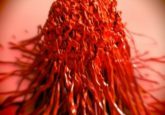New compound could effectively target resistant melanoma

A new compound that has been developed over the last 7 years at Sanford Burnham Prebys Medical Discovery Institute (CA, USA) has demonstrated preclinical efficacy when used in combination for the treatment of resistant melanoma. This first-in-class drug, termed SBI-756, has a unique target and could potentially benefit patients with advanced melanoma in the clinic. Details of these preclinical SBI-756 investigations were published recently in Cancer Research.
Within cancer cells there are often impairments to the translation initiation complex, which promotes the expression of extra proteins that support growth and survival of cancer cells. SBI-756 is designed to target the translation initiation complex and can cause it to dissociate.
There has been a concentrated effort to develop drugs that are able to target the translation initiation complex in recent years. SBI-756 is considered a first-in-class drug as it is the first successful attempt to target the eukaryotic translation initiation factor eIF4G1.
“The unique target of SBI-756 makes it especially promising for use in combination therapy,” commented senior author Ze’ev Ronai of Sanford Burnham Prebys Medical Discovery Institute. “A major issue limiting the effectiveness of current melanoma therapies is that tumors become resistant to treatment. Combining drugs that come at a melanoma from different angles may help overcome the problem of drug resistance.”
The BRAF inhibitor vemurafenib can be utilized in the treatment of melanomas that harbor causative BRAF mutations; an error estimated to be present in approximately 50% of all melanomas. However, malignancies develop resistance to this BRAF-targeting agent as they grow and evolve over time.
In their investigations, the Sanford Burnham team co-administered SBI-756 with vemurafenib in mouse models, observing that the combination promoted durable tumor eradication. This response was noted even in mice with advanced BRAF-driven cancer. These data together indicate that SBI-756 could provide a significant advantage in overcoming tumor resistance.
SBI-756 was also tested for antitumor activity in other manifestations of melanoma, specifically those caused by mutations in the NRAS and NF1 genes. Investigation will continue in these melanomas in order to determine whether combining SBI-756 with existing drugs can eliminate these tumors.
“The ability of this compound to delay or eliminate the formation of resistant melanomas is very exciting,” continued Ronai. “It appears that the dose we need to administer is very low. Even in the experiments where the drug was administered to mice with tumors over a significant period of time, we have not found any toxicity.”
The team at Sanford Burnham will now work on developing the next generation of the compound, which they hope can enter into early stage clinical trials.
Commenting on the wider context of the study, renowned leader in the field of protein translation Nahum Sonenberg (McGill University, Quebec, Canada) said: “The finding of SBI-756 is also exciting for the possible treatment of diseases other than cancer, such as neurodegenerative diseases, where the activity of the translation initiation complex is reported to be higher.”
Sources: Feng Y, Pinkerton AB, Hulea L et al. SBI-0640756 Attenuates the Growth of Clinically Unresponsive Melanomas by Disrupting the eIF4F Translation Initiation Complex. Cancer Res. DOI: 10.1158/0008-5472.CAN-15-0885 (2015) (Epub ahead of print); Sanford Burnham Prebys Medical Discovery Institute press release



